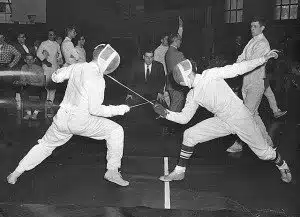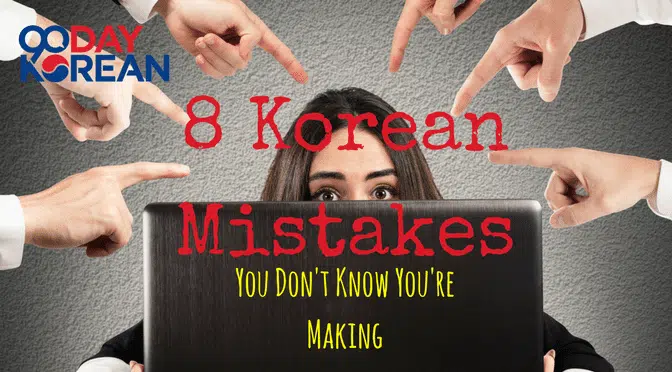If you know these common Korean mistakes ahead of time, then you’re going to be a few steps ahead of the game. Your Korean learning will be much smoother. Plus, you’ll look much cooler when you talk like a fluent Korean speaker in a short amount of time.
Below, we will cover the most common Korean language mistakes that people make. We’ll also fill you in on how to avoid these common mistakes.
Contents
- 1 Most Common Korean Language Mistakes
- 1.1 1. Smooth Finish: 안녕하세요 (annyeonghaseyo)
- 1.2 2. Botching the Badchims: 합니다 (hamnida)
- 1.3 3. Making Peace with the Irregular: 같이 (gachi)
- 1.4 4. Hana’s Number Duel: 둘 (dul)
- 1.5 5. Honorable Celebrations: 생일 (saengil)
- 1.6 6. Old School to New School: 와인 (wain)
- 1.7 7. Action Sandwich: 안 (an)
- 1.8 8. One Size Doesn’t Fit All: 포장 (pojang)
- 2 Bonus: Mistake in Korean
- 3 Summary
Most Common Korean Language Mistakes
Raise your hand if you’ve ever had this situation happen to you. You hit the Korean study books hard, head out to practice your newfound knowledge, and the people you talk to have no idea what you’re saying.
It’s a common situation for people who learn Korean as a second language. Oftentimes, Korean is the first language they’ve chosen to learn. The sounds, pronunciation, and intonation are far from their mother tongue, so it’s hard to replicate those sounds required for Korean. But rest assured, you’re not alone!
Think back to the opposite situation. Have you ever talked to people who were learning English as a second language? They may have tried to ask you something in English, but you had no idea what they said. If they persisted with the question, you probably found out that their pronunciation was slightly off. It’s a very similar situation to you speaking Korean.
When you run into this situation, the key is to keep at it. If the other person doesn’t understand what you are saying in Korean, try explaining it another way. You’ll find that your pronunciation or intonation was slightly off, and now you can find out the correct way to say it.
In short, keep going, and don’t give up! Luckily, there are ways to avoid this situation altogether. We’ll fill you in below!
1. Smooth Finish: 안녕하세요 (annyeonghaseyo)
One of the first phrases everyone learns when learning Korean is 안녕하세요 (annyeonghaseyo), which is a greeting similar to “hello.” Have you ever listened to Koreans pronounce this word? The ending is not pronounced the way it is written. Instead of finishing with a “요” (yo) sound, Koreans finish the greeting with a 여(yeo).
If you want to sound like a native Korean, pronounce your greeting like this: 안녕하세여 (annyeonghaseyeo).
Surprisingly, this becomes easier to recognize once you learn how to read the Hangeul. Being able to read the Korean alphabet helps you with proper Korean pronunciation and recognition, so if you don’t know it, then definitely learn.
2. Botching the Badchims: 합니다 (hamnida)
Many people learn the formal way to speak Korean early on, which is the -ㅂ니다 (- ㅂ nida) verb form. When you use this form, the ㅂ needs to get paired with the verb depending on the verb’s structure. Theㅂ is always in the bottom, or 받침 (batchim), position. Normally, the ㅂ has a “b” or “p” sound, depending on where it is in the word.
This is a special case! Instead of pronouncing 합니다 like hap-ni-da, you’re going to say it like “hamnida.” In Hangul, the pronunciation will look like 함니다 (hamnida).
Although it seems strange at first, it will make your life easier. If you try saying “hap-ni-da” vs. “hamnida,” you’ll notice the second one is easier to say. It flows more easily. Korean has developed rules similar to these, so look out for pronunciation that doesn’t seem to follow the rules.
If you want an easy trick to remember this one, try an association. “합니다” (hamnida) kind of sounds like “ham need a,” meaning that you need a ham. Around Chuseok (Korean Thanksgiving), a very common gift is to give Spam (the meat, not the email!). So you can think to yourself, “Around Chuseok, many people need a ham.” “Hamnida!”
3. Making Peace with the Irregular: 같이 (gachi)
Those irregular pronunciation words! Why do they have to make life so difficult?
The next violator we’re going to look at is 같이 (gachi), which means “together.” If you pronounce this word according to the rules of Hangul, it should sound like “ka-tee.” However, the correct pronunciation is “ka-chee” or 가치 (gachi).
Let’s link up an association to help commit this to your memory. 같이 (gachi) means “together.” In order to go somewhere “together” with your friends, first you need to “catch” them. “Ka-chee” sounds similar to “catchy”. In order to go somewhere “같이” (gachi) with your friend, first you need to “catchy” them.
4. Hana’s Number Duel: 둘 (dul)

Let’s talk numbers. Korean has two numbering systems. For simplicity’s sake, we’ll call them the China System (일 | il, 이 | i, 삼 | sam…) and the Korea System (하나 | hana, 둘 | dul, 셋 | set…).
The numbers for the Korean language are a bit burdensome because you have to learn two systems. Not only that, but you need to use different systems for different situations.
If you have managed to avoid pulling your hair out at this point, we applaud your patience and persistence! Rest assured, we’ll give you some help to make sure you’re using the correct ones.
One of the common Korean mistakes is using the China system to talk about age using 살 (sal) for years. A big no-no! If you’re talking about your 5-year-old nephew, his age is 다섯 살 (daseot sal), not 오살 (osal).
If your cousin is 14 years old, how would you express that in Korean?
A) 십사 살 (sipsa sal)
B) 열네 살 (yeolle sal)
If you said “B”, high-fives for you!
When you’re using age in Korean, you want to stick to the Korea System. An easy way to remember this is if you remember the story about Hana, the Korean fencing champion. She LOVES the Korean number system, and she frequently defends its honor. She is also sensitive about her age. Anytime someone talks about age incorrectly, she challenges them to a “set” of fencing “duels.”
Or put another way, when age comes up, “Hana” demands a “duel.” And she wants at least a full “set” of duels!
When age comes up, think 하나 (hana), 둘 (dul), 셋 (set).
We hope this helps you steer clear of any upcoming duels!
5. Honorable Celebrations: 생일 (saengil)

Koreans value honor and social rank. It’s deeply ingrained in the Korean language in a number of ways.
One way is the special vocabulary that is used for those higher in the social ranks than us. One clear example of this is when you’re talking about your parents or grandparents.
Suppose their birthday is coming up. If you tell your Korean friend that it’s their 생일 (saengil | birthday), then you give your ancestors a verbal slap in the face. How rude!
The correct word for your parent’s birthday is 생신 (saengsin).
Although you are forgiven as a Korean learner, it’s much better to use the proper word. Not only will you be more respectful to your parents in the eyes of Koreans, but you’ll also sound more like a fluent speaker!
If you need an association, think of your shin. If you told your dad that it was his 생일 (saengil), he would kick you in the shin and say 생신 (saengsin)!
6. Old School to New School: 와인 (wain)
One challenging part of learning Korean is knowing when to use the correct word. For example, maybe you want to learn the word for “wine” in Korean. One source says 포도주 (podoju), and the other says 와인 (wain). Which one is correct?
The best word to use is 와인 (wain). Since there is a big push to learn English here, some of the older Korean vocabulary is replaced with the English word sounded out in Korean.
If there are two choices for a word in Korean, and one of them sounds like English, that’s generally the best one to use. It’s more recent and likely more commonly used. It’s not a hard and fast rule, but a good guideline to use to keep your Korean flowing smoothly.
7. Action Sandwich: 안 (an)
One of the Korean mistakes that stands out is the word “not.”
In Korean, “not” can be expressed using 안 (an).
So you can simply pop it in front of a word. For example, if you’re saying you’re not busy (바빠요 | bappayo), you can say 안 바빠요 (an bappayo).
This works fine in most verb and adjective cases. There is one exception, which is with 하다 action verbs.

Examples of this would be:
일하다 – ilhada | to work
운동하다 – undonghada | to exercise
운전하다 – unjeonhada | to drive
You cannot add the 안 (an) at the beginning of the verb like in most other cases. These verbs are very particular about how they get along with 안 (an). This is wrong:
안 일해요 (an ilhaeyo) – (X)
안 운동해요 (an undonghaeyo) – (X)
안 운전해요 (an unjeonhaeyo) – (X)
Embarrassing!
Instead, you need to sandwich the 안 (an) between the beginning part of the verb (noun portion) and the 하다 (hada). It will look like this:
일 안해요 (il anhaeyo) – (O)
운동 안해요 (undong anhaeyo) – (O)
운전 안해요 (unjeon anhaeyo) – (O)
Using this rule is a simple way to make your Korean more natural sounding.
To help remember, think about how society rewards action-takers. They make the effort so they get to reap the benefits.
Well, 하다 (hada) action verbs are similar. They are always hard at work, so sometimes we tell them to take a break. We tell them “not” to work. We do this by giving them a sandwich. In other words, we “sandwich” the 안 (an | not) between the beginning of the verb and the 하다 (hada).
Is anyone else getting hungry?
8. One Size Doesn’t Fit All: 포장 (pojang)
Korea is a fashion-conscious country, so they are very particular about the fit of their clothes. Clothing is either the precise size or it’s custom-made. No one size fits all!
Well, the same is true of their verbs. If you’ve studied everyday Korean phrases, you may notice specific differences. One great example is from Korean cafe vocabulary.
Let’s say you’re ordering at a cafe in Korea.

If you’re ordering only coffee to go, then you’d say 테이크 아웃이에요 (teikeu ausieyo).
If you’re ordering coffee and food to go, then you’d say 포장해 주세요 (pojanghae juseyo).
포장 (pojang) is the word that’s often used in Korean when referring to packing up food and taking it to go. It is quite common.
However, this word sounds strange to Koreans if you use it for coffee and drinks.
If you want to order like a pro, make sure you know these differences. Koreans appreciate good fit when it comes to both clothes and Korean vocabulary! Now find a good cafe to try them out. ^^
Bonus: Mistake in Korean
While you’re learning about the common language mistakes people make when studying Korean, we thought it would be helpful for you to know how to say “Mistake” in Korean.
There are 2 ways you can say the word “mistake” in Korean. You can say it as 실수 (silsu) and 잘못 (jalmot). However, these words can have different connotations when used in a sentence. 실수 (silsu) can mean “mistake” while 잘못 (jalmot) can mean “fault”.
For example,
제가 실수했어요. (jega silsuhaesseoyo)
I’ve made a mistake.
제 잘못이에요. (je jalmosieyo)
It was my fault.
Summary
Learning Korean isn’t as hard as you think. Integrate these simple 8 rules into your Korean learning, and you’ll be talking more and more like a native speaker every day. You’ll commit less and less of these common mistakes Korean learners make. And remember, making mistakes is a part of the process, so don’t let that stop you from trying! Even Korean-speaking experts are used to making mistakes in Korean grammar. It’s all part of the process of learning.
What Korean mistakes do you hear most often? Leave your comment below!






Really love to learn from you♡
Thanks, Aj! Keep going! ^^
Thanks for your effort I learn a lot from you keep up the good work
Thanks for your kind words, Habiba! ^^
I want learn Korean
Hi Ibrahem! You can start from learning Hangeul (Korean alphabet): 90daykorean.com/how-to-learn-the-korean-alphabet/ ^^
이제는, 더 이해요. 감사합니다! ^_^
아니에요! (You’re welcome!) ^^
daebakkk! i really’ve learnt alot from here! thank you for sharing these precious infos, thank youuu
So happy we could help! ^^